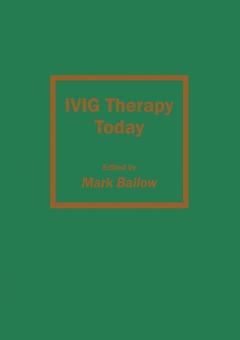Description
IVIG Therapy Today, Softcover reprint of the original 1st ed. 1992
Allergy and Immunology Series, Vol. 2
Author: Ballow Mark
Language: English
Subject for IVIG Therapy Today:
Keywords
asthma; autoimmune disease; bacteria; diseases; immunoglobulin; immunotherapy; infection; infections; leukemia; lipide
Approximative price 105.49 €
In Print (Delivery period: 15 days).
Add to cart
Publication date: 04-2013
146 p. · 17.8x25.4 cm · Paperback
146 p. · 17.8x25.4 cm · Paperback
Description
/li>Contents
/li>
It has been little more than a century since Emil von Behring and his colleagues (1890) showed that the blood of tetanus-immune rabbits contained a factor that could be transferred to nonimmune animals to protect them against tetanus. These observations, together with the work of Paul Ehrlich, started scientists on the long and complex path to our present understanding of the humoral, or B-cell, immune system. These early studies led to Nobel prize awards for von Behring (1901 ) and Ehrlich (1908), each of whom contributed much to our knowledge of the B-cell immune system. In the early 20th century it was recognized that the serum of individuals who had recently suffered an infection contained a protective humoral factor that could be transferred to a nonimmune person, thereafter affording that individual protection against the infectious agent that had caused disease. In 1933 McKhann and Chu reported that a placental extract containing the globulin fraction could modify measles. However, it was not until 1939 that Tiselius and Kabat demonstrated that the antibodies responsible for protection against these infectious disorders resided within the gammaglobulin plasma fraction. In a major step forward, Cohn in 1944 established a method for the fractionation and purification of this plasma gammaglobulin fraction. These procedures, which are based on cold ethanol precipitation of plasma, produce a readily adaptable, large-scale fractionation procedure that is still utilized to this day in the preparation of commercial gammaglobulin.
Introduction. Clinical Use of Intravenous Immune Serum Globulin as Replacement Therapy in Patients with Primary Immune Deficiency Syndrome. Current Status of Intravenous Immunoglobulin in Preventing or Treating Neonatal Bacterial Infections. The Potential Use of Monoclonal Antibodies as Therapeutic Modalities in Neonatal Infection. Immune Deficiencies in Chronic Lymphocytic Leukemia and Multiple Myeloma. IVIG in the Treatment of Children with Acute and Chronic Idiopathic Thrombocytopenic Purpura and the Autoimmune Cytopenias. IVIG Therapy in Neonatal Isoimmune Thrombocytopenic Purpura and Alloimmunization Thrombocytopenia. The Clinical Efficacy of IVGG in Kawasaki Disease. The Immunoregulatory Effects of IVIG in Kawasaki Disease and Other Autoimmune Diseases. The Uses of Intravenous Immune Serum Globulin in the Management of Patients with Antiphospholipid Antibodies and Recurrent Pregnancy Losses. The Use of Intravenous Gamma Globulin in Neurologic Diseases. Use of IV gg in the Management of Asthma. Index.
© 2024 LAVOISIER S.A.S.




